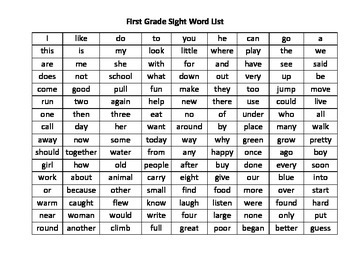

Sounding out words, or decoding, uses up a lot of cognitive energy and attention. In order to read a word, a child must first be able to recognize individual letters and sets of letters and then map the correct sounds onto them. A child who is a strong reader from an early age may find he or she acquires sight words effortlessly through repeat exposure from extensive reading.īut these words may require some extra effort and time for other students to learn, particularly if they are struggling to keep up with peers when it comes to reading.Ĭhildren develop pre-literacy skills, including individual sound, letter and word recognition, through conversations with caregivers and being read to from an early age.

Sight words for first grade how to#
Most children are introduced to sight words in first or second grade when they begin learning how to read. More than 75% of the average children's book is made up of sight words. Mastering them frees up attention for processing harder and lower frequency words. That's because they are the most common English words used in writing. Sometimes you'll find sight words referred to as high-frequency words. They are useful for young children to know, but also a good idea for struggling readers.Įnglish as an additional, second, or foreign language learners, especially those who are just getting started with reading and writing, will also benefit from studying sight words.

When a student learns to recognize sight words automatically, it can increase his or her reading fluency and comprehension. This is why they are so important to teach. They're called sight words because if you learn to recognize them by sight, instead of having to sound them out, it makes reading easier. Sight words are the English words you most frequently encounter when reading.


 0 kommentar(er)
0 kommentar(er)
